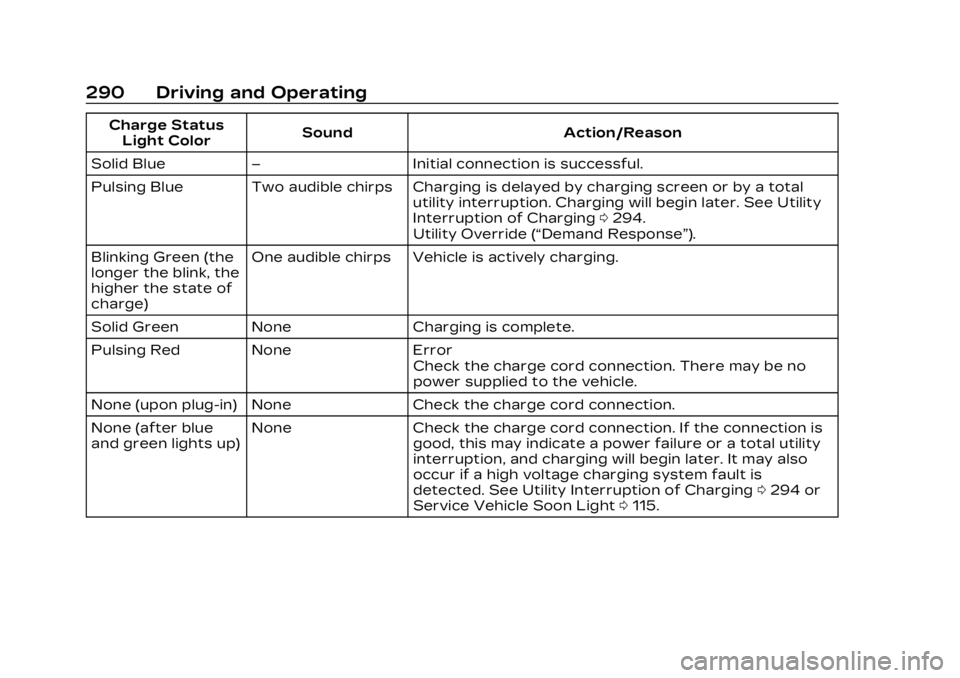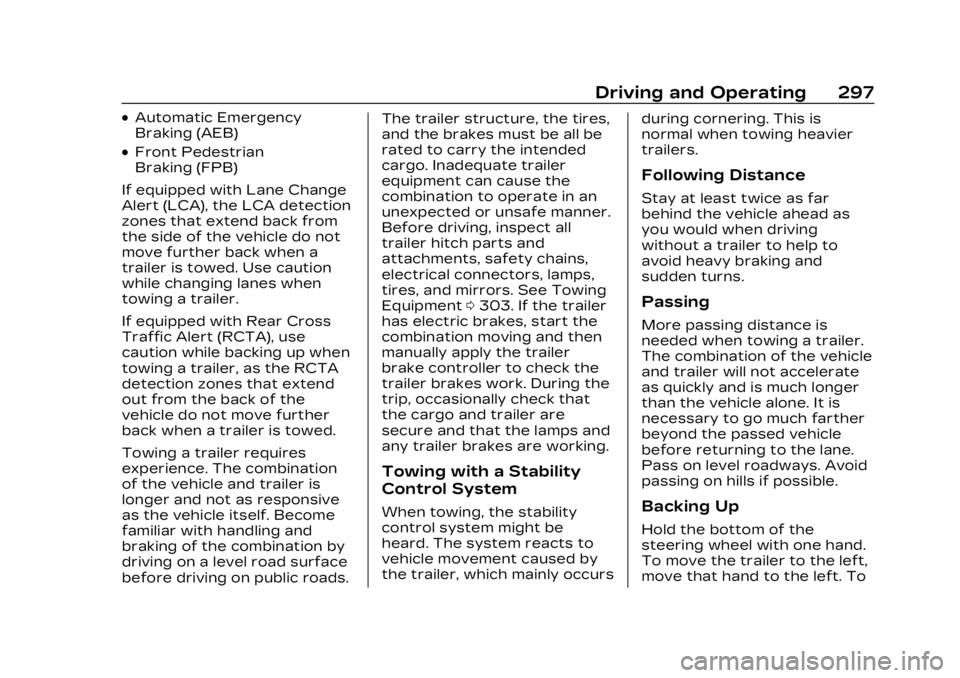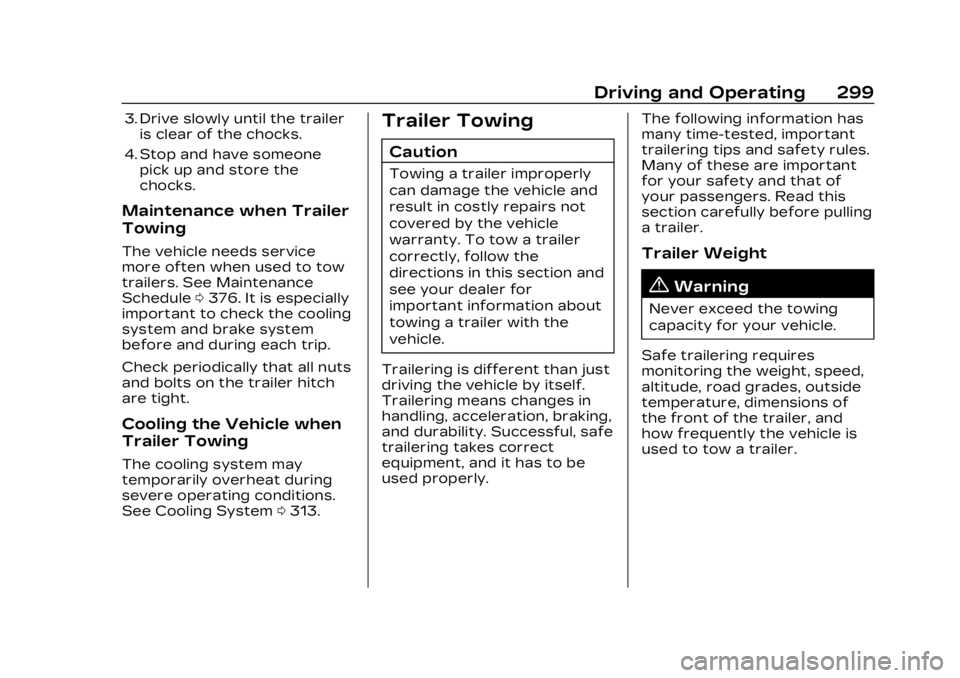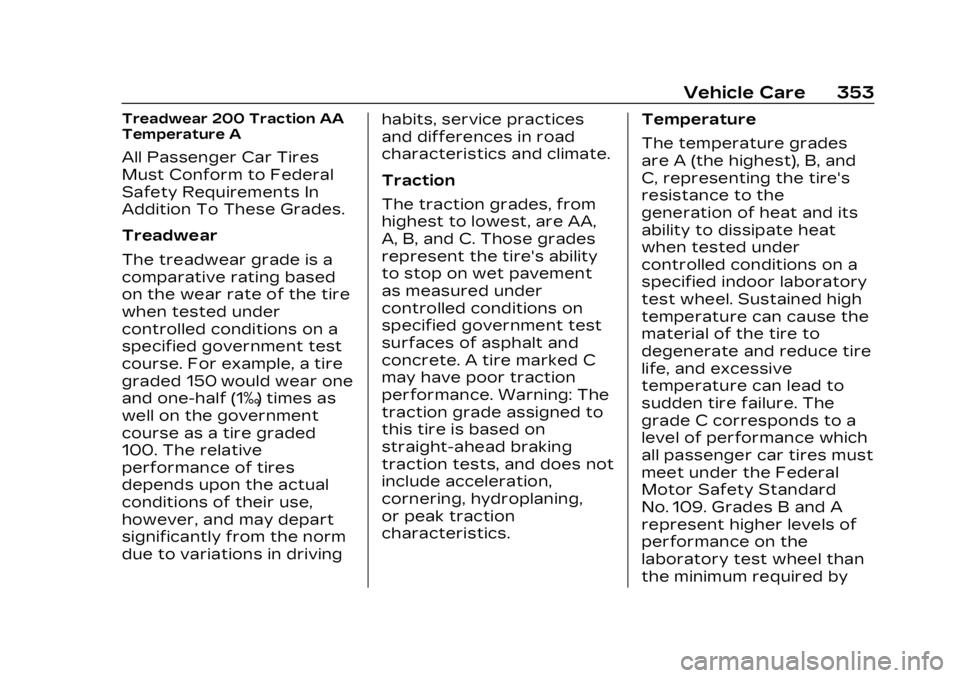2023 CADILLAC LYRIC ESP
[x] Cancel search: ESPPage 291 of 424

Cadillac Lyriq Owner Manual (GMNA-Localizing-U.S./Canada-15644413) -
2023 - CRC - 2/23/22
290 Driving and Operating
Charge StatusLight Color Sound Action/Reason
Solid Blue – Initial connection is successful.
Pulsing Blue Two audible chirps Charging is delayed by charging screen or by a total utility interruption. Charging will begin later. See Utility
Interruption of Charging0294.
Utility Override (“Demand Response”).
Blinking Green (the
longer the blink, the
higher the state of
charge) One audible chirps Vehicle is actively charging.
Solid Green None Charging is complete.
Pulsing Red None Error Check the charge cord connection. There may be no
power supplied to the vehicle.
None (upon plug-in) None Check the charge cord connection.
None (after blue
and green lights up) None Check the charge cord connection. If the connection is
good, this may indicate a power failure or a total utility
interruption, and charging will begin later. It may also
occur if a high voltage charging system fault is
detected. See Utility Interruption of Charging 0294 or
Service Vehicle Soon Light 0115.
Page 295 of 424

Cadillac Lyriq Owner Manual (GMNA-Localizing-U.S./Canada-15644413) -
2023 - CRC - 2/23/22
294 Driving and Operating
Verify the charge cord status.
The charge cord uses a
combination of red, blue, and
yellow indicators to display the
status of the charge cord.
If the status indicator is not lit,
ensure the electrical outlet
has power.
Charge Level Selection
Charge level selection can be
made using the Charging tab
in the Energy Application on
the infotainment display. For
instructions to set cord limit
settings for a charge session,
see Charging0123.
{Warning
Using a charge level that
exceeds the electrical circuit
or electrical outlet capacity
may start a fire or damage
the electrical circuit. Use the
lowest charge level until a
qualified electrician inspects
the electrical circuit
capacity. Use the lowest
(Continued)
Warning (Continued)
charge level if the electrical
circuit or electrical outlet
capacity is not known.
Grounding Instructions
The charge circuit must be
grounded. If the charge circuit
should malfunction or break
down, grounding provides a
path of least resistance for
the electric current to reduce
the risk of electric shock. This
product is equipped with a
cord that has an equipment
grounding conductor and a
grounding plug. The plug must
be plugged into an appropriate
outlet that is properly installed
and grounded in accordance
with all local codes and
ordinances.
{Warning
Improper connection of the
charge cord ground may
cause electrical shock.(Continued)
Warning (Continued)
Check with a qualified
electrician if there is doubt
as to whether the charge
circuit is properly grounded.
Do not modify the plug
provided with the product.
If it will not fit the electrical
outlet, have a proper
electrical outlet installed by
a qualified electrician.
FCC Information
See Radio Frequency
Statement0395.
Utility Interruption of
Charging
This vehicle responds to
requests through the utility
company to limit or completely
block electrical power grid use.
This feature is inactive during
DC charging. A utility
interruption will lengthen the
vehicle charge time.
Page 298 of 424

Cadillac Lyriq Owner Manual (GMNA-Localizing-U.S./Canada-15644413) -
2023 - CRC - 2/23/22
Driving and Operating 297
.Automatic Emergency
Braking (AEB)
.Front Pedestrian
Braking (FPB)
If equipped with Lane Change
Alert (LCA), the LCA detection
zones that extend back from
the side of the vehicle do not
move further back when a
trailer is towed. Use caution
while changing lanes when
towing a trailer.
If equipped with Rear Cross
Traffic Alert (RCTA), use
caution while backing up when
towing a trailer, as the RCTA
detection zones that extend
out from the back of the
vehicle do not move further
back when a trailer is towed.
Towing a trailer requires
experience. The combination
of the vehicle and trailer is
longer and not as responsive
as the vehicle itself. Become
familiar with handling and
braking of the combination by
driving on a level road surface
before driving on public roads. The trailer structure, the tires,
and the brakes must be all be
rated to carry the intended
cargo. Inadequate trailer
equipment can cause the
combination to operate in an
unexpected or unsafe manner.
Before driving, inspect all
trailer hitch parts and
attachments, safety chains,
electrical connectors, lamps,
tires, and mirrors. See Towing
Equipment
0303. If the trailer
has electric brakes, start the
combination moving and then
manually apply the trailer
brake controller to check the
trailer brakes work. During the
trip, occasionally check that
the cargo and trailer are
secure and that the lamps and
any trailer brakes are working.
Towing with a Stability
Control System
When towing, the stability
control system might be
heard. The system reacts to
vehicle movement caused by
the trailer, which mainly occurs during cornering. This is
normal when towing heavier
trailers.
Following Distance
Stay at least twice as far
behind the vehicle ahead as
you would when driving
without a trailer to help to
avoid heavy braking and
sudden turns.
Passing
More passing distance is
needed when towing a trailer.
The combination of the vehicle
and trailer will not accelerate
as quickly and is much longer
than the vehicle alone. It is
necessary to go much farther
beyond the passed vehicle
before returning to the lane.
Pass on level roadways. Avoid
passing on hills if possible.
Backing Up
Hold the bottom of the
steering wheel with one hand.
To move the trailer to the left,
move that hand to the left. To
Page 300 of 424

Cadillac Lyriq Owner Manual (GMNA-Localizing-U.S./Canada-15644413) -
2023 - CRC - 2/23/22
Driving and Operating 299
3. Drive slowly until the traileris clear of the chocks.
4. Stop and have someone pick up and store the
chocks.
Maintenance when Trailer
Towing
The vehicle needs service
more often when used to tow
trailers. See Maintenance
Schedule 0376. It is especially
important to check the cooling
system and brake system
before and during each trip.
Check periodically that all nuts
and bolts on the trailer hitch
are tight.
Cooling the Vehicle when
Trailer Towing
The cooling system may
temporarily overheat during
severe operating conditions.
See Cooling System 0313.
Trailer Towing
Caution
Towing a trailer improperly
can damage the vehicle and
result in costly repairs not
covered by the vehicle
warranty. To tow a trailer
correctly, follow the
directions in this section and
see your dealer for
important information about
towing a trailer with the
vehicle.
Trailering is different than just
driving the vehicle by itself.
Trailering means changes in
handling, acceleration, braking,
and durability. Successful, safe
trailering takes correct
equipment, and it has to be
used properly. The following information has
many time-tested, important
trailering tips and safety rules.
Many of these are important
for your safety and that of
your passengers. Read this
section carefully before pulling
a trailer.
Trailer Weight
{Warning
Never exceed the towing
capacity for your vehicle.
Safe trailering requires
monitoring the weight, speed,
altitude, road grades, outside
temperature, dimensions of
the front of the trailer, and
how frequently the vehicle is
used to tow a trailer.
Page 341 of 424

Cadillac Lyriq Owner Manual (GMNA-Localizing-U.S./Canada-15644413) -
2023 - CRC - 2/23/22
340 Vehicle Care
DOT Markings:A code
molded into the sidewall of
a tire signifying that the
tire is in compliance with
the U.S. Department of
Transportation (DOT)
Motor Vehicle Safety
Standards. The DOT code
includes the Tire
Identification Number (TIN),
an alphanumeric designator
which can also identify the
tire manufacturer,
production plant, brand,
and date of production.
GVWR
:Gross Vehicle
Weight Rating. See Vehicle
Load Limits 0202.
GAWR FRT
:Gross Axle
Weight Rating for the front
axle. See Vehicle Load
Limits 0202.
GAWR RR
:Gross Axle
Weight Rating for the rear
axle. See Vehicle Load
Limits 0202. Intended Outboard
Sidewall
:The side of an
asymmetrical tire, that
must always face outward
when mounted on a vehicle.
Kilopascal (kPa)
:The
metric unit for air pressure.
Light Truck (LT-Metric)
Tire
:A tire used on light
duty trucks and some
multipurpose passenger
vehicles.
Load Index
:An assigned
number ranging from 1 to
279 that corresponds to
the load carrying capacity
of a tire.
Maximum Inflation
Pressure
:The maximum
air pressure to which a cold
tire can be inflated. The
maximum air pressure is
molded onto the sidewall. Maximum Load Rating
:
The load rating for a tire at
the maximum permissible
inflation pressure for
that tire.
Occupant Distribution
:
Designated seating
positions.
Outward Facing Sidewall
:
The side of an
asymmetrical tire that has
a particular side that faces
outward when mounted on
a vehicle. The side of the
tire that contains a
whitewall, bears white
lettering, or bears
manufacturer, brand, and/
or model name molding
that is higher or deeper
than the same moldings on
the other sidewall of
the tire.
Page 344 of 424

Cadillac Lyriq Owner Manual (GMNA-Localizing-U.S./Canada-15644413) -
2023 - CRC - 2/23/22
Vehicle Care 343
Remove the valve cap from
the tire valve stem. Press
the tire gauge firmly onto
the valve to get a pressure
measurement. If the cold
tire inflation pressure
matches the recommended
pressure on the Tire and
Loading Information label,
no further adjustment is
necessary. If the inflation
pressure is low, add air
until the recommended
pressure is reached. If the
inflation pressure is high,
press on the metal stem in
the center of the tire valve
to release air.
Recheck the tire pressure
with the tire gauge.
Put the valve caps back on
the valve stems to keep out
dirt and moisture. Use only
valve caps designed for the
vehicle by GM. TPMSsensors could be damaged
and would not be covered
by the vehicle warranty.
Tire Pressure Monitor
System
The Tire Pressure Monitor
System (TPMS) uses radio and
sensor technology to check
tire pressure levels. The TPMS
sensors monitor the air
pressure in your tires and
transmit tire pressure
readings to a receiver located
in the vehicle.
Each tire, including the spare
(if provided), should be
checked monthly when cold
and inflated to the inflation
pressure recommended by the
vehicle manufacturer on the
vehicle placard or tire inflation
pressure label. (If your vehicle
has tires of a different size
than the size indicated on the
vehicle placard or tire inflation
pressure label, you should determine the proper tire
inflation pressure for those
tires.)
As an added safety feature,
your vehicle has been
equipped with a tire pressure
monitoring system (TPMS)
that illuminates a low tire
pressure telltale when one or
more of your tires is
significantly under-inflated.
Accordingly, when the low tire
pressure telltale illuminates,
you should stop and check
your tires as soon as possible,
and inflate them to the proper
pressure. Driving on a
significantly under-inflated tire
causes the tire to overheat
and can lead to tire failure.
Under-inflation also reduces
energy efficiency and tire
tread life, and may affect the
vehicle's handling and
stopping ability.
Please note that the TPMS is
not a substitute for proper tire
maintenance, and it is the
driver's responsibility to
Page 353 of 424

Cadillac Lyriq Owner Manual (GMNA-Localizing-U.S./Canada-15644413) -
2023 - CRC - 2/23/22
352 Vehicle Care
Different Size Tires
and Wheels
If wheels or tires are installed
that are a different size than
the original equipment wheels
and tires, vehicle performance,
including its braking, ride and
handling characteristics,
stability, and resistance to
rollover may be affected. If the
vehicle has electronic systems
such as antilock brakes,
rollover airbags, traction
control, electronic stability
control, or All-Wheel Drive, the
performance of these systems
can also be affected.
{Warning
If different sized wheels are
used, there may not be an
acceptable level of
performance and safety if
tires not recommended for
those wheels are selected.
This increases the chance of
a crash and serious injury.(Continued)
Warning (Continued)
Only use GM specific wheel
and tire systems developed
for the vehicle, and have
them properly installed by a
GM certified technician.
See Buying New Tires 0350
and Accessories and
Modifications 0308.
Uniform Tire Quality
Grading
The following information
relates to the system
developed by the United
States National Highway
Traffic Safety
Administration (NHTSA),
which grades tires by
treadwear, traction, and
temperature performance.
This applies only to
vehicles sold in the United
States. The grades are
molded on the sidewalls of
most passenger car tires. The Uniform Tire Quality
Grading (UTQG) system
does not apply to deep
tread, winter tires, compact
spare tires, tires with
nominal rim diameters of
10 to 12 inches
(25 to 30 cm), or to some
limited-production tires.
While the tires available on
General Motors passenger
cars and light trucks may
vary with respect to these
grades, they must also
conform to federal safety
requirements and
additional General Motors
Tire Performance Criteria
(TPC) standards.
Quality grades can be
found where applicable on
the tire sidewall between
tread shoulder and
maximum section width.
For example:
Page 354 of 424

Cadillac Lyriq Owner Manual (GMNA-Localizing-U.S./Canada-15644413) -
2023 - CRC - 2/23/22
Vehicle Care 353
Treadwear 200 Traction AA
Temperature A
All Passenger Car Tires
Must Conform to Federal
Safety Requirements In
Addition To These Grades.
Treadwear
The treadwear grade is a
comparative rating based
on the wear rate of the tire
when tested under
controlled conditions on a
specified government test
course. For example, a tire
graded 150 would wear one
and one-half (1½) times as
well on the government
course as a tire graded
100. The relative
performance of tires
depends upon the actual
conditions of their use,
however, and may depart
significantly from the norm
due to variations in drivinghabits, service practices
and differences in road
characteristics and climate.
Traction
The traction grades, from
highest to lowest, are AA,
A, B, and C. Those grades
represent the tire's ability
to stop on wet pavement
as measured under
controlled conditions on
specified government test
surfaces of asphalt and
concrete. A tire marked C
may have poor traction
performance. Warning: The
traction grade assigned to
this tire is based on
straight-ahead braking
traction tests, and does not
include acceleration,
cornering, hydroplaning,
or peak traction
characteristics.
Temperature
The temperature grades
are A (the highest), B, and
C, representing the tire's
resistance to the
generation of heat and its
ability to dissipate heat
when tested under
controlled conditions on a
specified indoor laboratory
test wheel. Sustained high
temperature can cause the
material of the tire to
degenerate and reduce tire
life, and excessive
temperature can lead to
sudden tire failure. The
grade C corresponds to a
level of performance which
all passenger car tires must
meet under the Federal
Motor Safety Standard
No. 109. Grades B and A
represent higher levels of
performance on the
laboratory test wheel than
the minimum required by